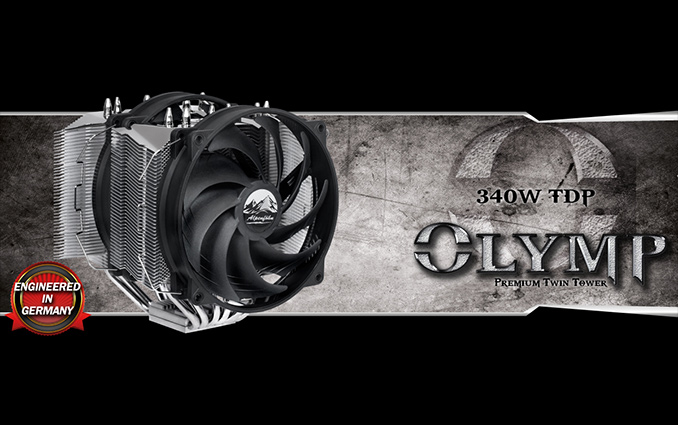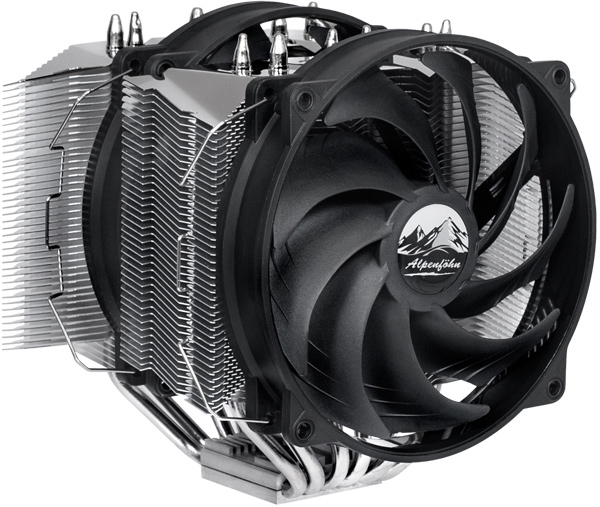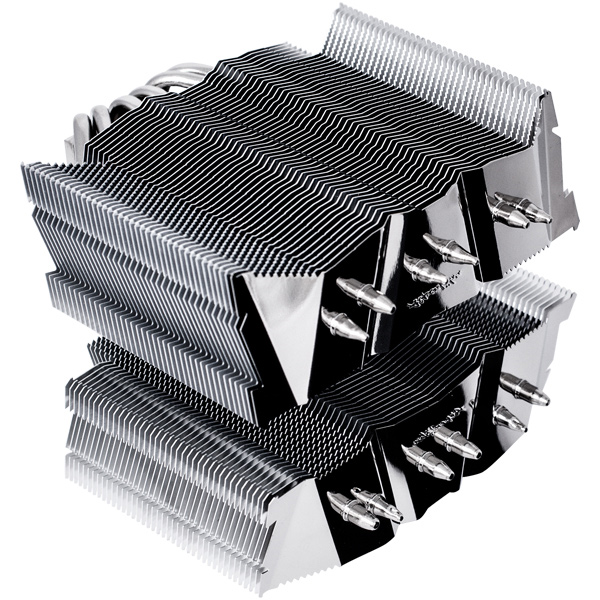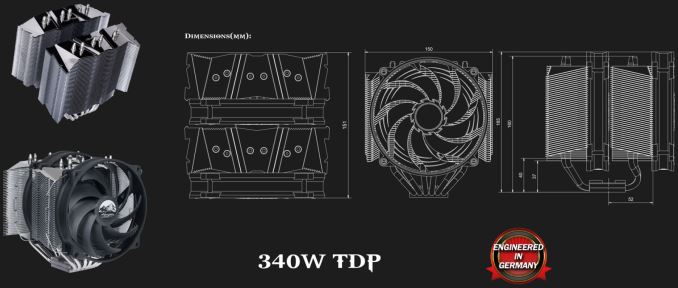Alpenföhn Unveils Olymp: A Giant Air Cooler Rated for 340W TDP
by Anton Shilov on February 4, 2016 10:00 AM EST- Posted in
- Cases/Cooling/PSUs
- AMD
- Intel
- Cooler
- Alpenföhn
- Alpenfoehn
- Olymp

As the market for PC CPU coolers has matured over the last half-decade or so and closed loop liquid coolers have encroached in the space, we haven't seen very many announcements of high-end CPU air coolers. However when we do see new coolers announced, they tend to aim for the stars, and now cooler manufacturer Alpenföhn is doing just that. This week the company is announcing their new Olymp cooler, a rather large tower CPU cooler rated to dissipate up to 340W of heat.
The Alpenföhn Olymp is an oversized asymmetric twin-tower cooler made of aluminum with a nickel-plated copper base as well as six U-shaped 6-mm nickel-plated heat-pipes. The heatsink is 165x151x150mm in size and weighs 1.2 kilograms (without fans); it requires a special mounting mechanism with custom retention plates and will not fit into many small form-factor PC cases (especially with fans installed). The sides of the fins of the heatsink are slightly bent in order to make the most of their surface area and to optimize airflow.
Alpenföhn does not disclose exact cooling fin surface area of the Olymp, but it is pretty clear that it is huge. While heatsinks of such weight and dimensions can cool-down even higher-end CPUs passively (for example, Thermalright positions its HR22 and Macho Zero as passive cooling solutions), the Alpenföhn Olymp can be equipped with 140-mm fans to maximize its potential. Since the cooler is gargantuan, to ensure maximum compatibility with memory modules Alpenföhn proposes installing one fan between the towers and another on the backside of the cooler. Such configuration is common for oversized coolers and it's a rather straightforward solution for dual-channel memory platforms (i.e., LGA115x, FM2/AM3, etc.). However users of quad-channel memory platforms (i.e., LGA2011, where modules are installed on both sides of the CPU socket) will have to adjust height of front and/or back fans so not restrict the installation of memory modules in slots that need to be used.
The Alpenfoehn Olymp is shipped with two WingBoost 140-mm fans with PWM control that have 300 – 1400 RPM speed and can push up to 123.38 m3 of air per hour. The airflow pressure of Olymp’s fans is slightly lower than that of the competing Noctua NH-D15 (140.2 m3/h), but with a heatsink that large, it shouldn't matter much for the vast majority of real-world use cases. The fans are rated to produce from 8 to 26.8 dbA of noise — just slightly louder than the maximum amount noise declared for the NH-D15. Alpenföhn rates its fans for 280 thousand hours MTTF (mean time till failure), or about 32 years of 24/7 operation.
The manufacturer believes that its Olymp cooler can effectively dissipate up to 340 W of heat, an extreme amount that greatly exceeds any reasonable TDP of a commercial chip. The Alpenfoehn Olymp will compete against other super-coolers, including Thermalright SilverArrow Extreme (officially rated for 320 W TDP), as well as advanced liquid cooling solutions.
The Alpenföhn Olymp is compatible with virtually all modern CPU platforms, including Intel’s LGA115x, LGA2011 and LGA775 as well as AMD’s AM2/AM3 and FM1. Keeping in mind its huge dimensions and weight, it makes a lot of sense to check thoroughly whether the cooler is compatible with a particular setup before purchase. The cooler is available for €79.9 in various stores across Europe.













47 Comments
View All Comments
BrokenCrayons - Friday, February 5, 2016 - link
As someone who's experienced exactly no problems ever with the HSF a manufacturer includes with the CPU, point of this thing seems merely to charge an unreasonable sum for a pointless product. You know what they say about fools and their money.extide - Friday, February 5, 2016 - link
Many high end CPU's don't come with coolers, and also pretty much all enthusiasts do use aftermarket coolers, and overclock. Your experience is somewhat irrelevant.Sivar - Friday, February 5, 2016 - link
Indeed if you use practical, inexpensive CPUs and do not overclock, the only reason to get a large cooler is to reduce (or eliminate) fan noise.Those of us that eschew pragmatism need to buy coolers to handle the load of overclocked, hot CPUs that ship without OEM HSFs.
xrror - Saturday, February 6, 2016 - link
"As someone who's experienced exactly no problems ever with the (stock) HSF (...)"Congratulations non-overclocker! This product is not targeted at you!
blzd - Thursday, February 11, 2016 - link
I enjoy quiet PCs that make minimal noise. Something that can never be achieved with a stock HSF.BrokenCrayons - Thursday, February 11, 2016 - link
For a quiet computer, I opt for something that doesn't need a fan at all like one of the many Bay/Cherry Trail laptops kicking around out there that have no moving parts inside.As for boxed HSFs, once again, I don't find them overly noisy and I value my silence. There were days ages ago when I went to great lengths to overclock things with thermoelectric coolers and water pumps, fiddling with DIP switches and jumper blocks. Now, if I need a faster computer, I just go buy a new one. They're just as disposable now as solar powered pocket calculators were in the 1990s so I put forth minimal effort in that kind of thing.
Sivar - Friday, February 5, 2016 - link
`Alpenföhn rates its fans for 280 thousand hours MTTF (mean time till failure), or about 32 years of 24/7 operation.`As an Anandtech employee, you should understand what MTTF and MTBF mean, and that isn't it any more than Seagate's 700,000 hour rating means their drives are rated for 80 years of 24/7 operation.
moozooh - Sunday, February 14, 2016 - link
^ This, very much. MBTF/MTTF are not (and should not be) treated as a direct value. It's a very confusing, roundabout, silly way for a company to look good with large numbers, but what it really means is that during a fixed-time test (say 175 days, which is 4200 hrs) a given number of fans (say, 200) have been working 24/7, and by the end of the test n fans (say, 3) have given out. 4200*200/3=280000. This is how it's calculated.To make use (or sense) of this number you need to convert it into a probability percentage. If I did the calculation correctly, that gives me a ~3.1% probability of a fan failure in the first year, and a ~14.5% probability of a fan failure in the first five years of operation. Those are merely okay numbers, in line with other high-quality fans out there; nothing special.
moozooh - Sunday, February 14, 2016 - link
Tl;dr MTTF =/= expected longevity.Sivar - Friday, February 5, 2016 - link
I hope this cooler can be included in a comparison review which includes the Noctua NH-D15 (mentioned in the article) and others.The Alpenföhn is about 20% larger by mass than the 'D15. It would be great to see what a difference this makes, especially with both coolers using the same fans so the heatsinks design alone is an isolated variable.